Have you ever wondered what it takes to build a successful brand? If so, you'll want to look at the concept of brand strategy. A brand strategy helps create and maintain an attractive image for your business in the minds of your customers.
What Is a Brand Strategy?
Comprehensive branding services encompass logo design, brand identity development, brand strategy, market analysis, and strategic brand positioning to ensure a cohesive and impactful brand image.
Brand strategy is an intricate and systematic plan designed to help businesses create a unique identity and increase their profit. It is a fundamental component of brand marketing, allowing companies to differentiate themselves from their competitors and make a lasting impression on their target audiences.
A strong brand strategy involves researching the company's core values and mission statement, setting goals for the brand, creating a messaging platform, understanding target audiences, building brand recognition, maintaining brand consistency across all platforms, identifying customer needs, and creating customer experiences. It also involves setting pricing points in line with the brand value proposition and determining suitable distribution channels.
Brand Strategy Plan by Clay
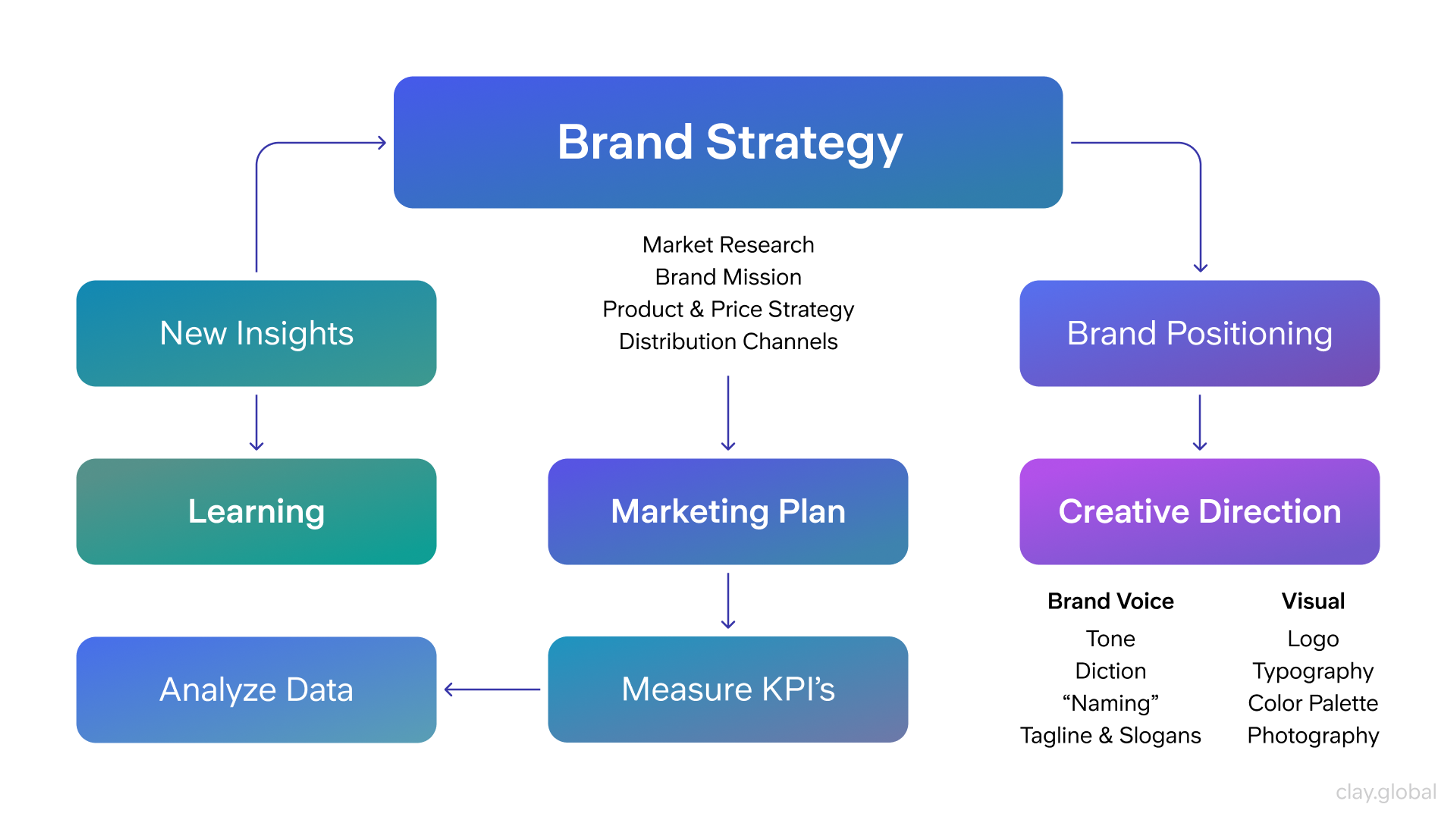
Why Is Branding Strategy Important?
Brand strategy is essential to brand marketing and critical to any successful business. A well-crafted brand strategy enables businesses to build recognition and admiration among customers while positioning them for long-term success.
For crypto and Web3 companies, a solid brand strategy helps demystify complex technologies, and fosters trust in a decentralized, often unfamiliar space.
By carefully choosing a comprehensive brand strategy, companies can ensure that they effectively communicate the right message to the right audience at the right time. Branding strategy is essential for increasing profits and building consumer relationships that will last into the future. Let's take a look at some figures:
- Developing an emotional connection with customers can yield a staggering 306% higher lifetime value for your brand.
- To ensure your brand is consistent across all platforms, you must carry the same branding to every channel and media platform where you have a presence. After all, customers expect 90% of their experience with your brand to be seamless regardless of the platform they use.
- According to a survey of expert marketers, brand awareness is deemed the most important goal, with an impressive 84% endorsement.
- Branded content can captivate and engage with your audience more than 22 times better than a standard display ad.
Brand Strategy Component Examples and Their Meanings by Clay
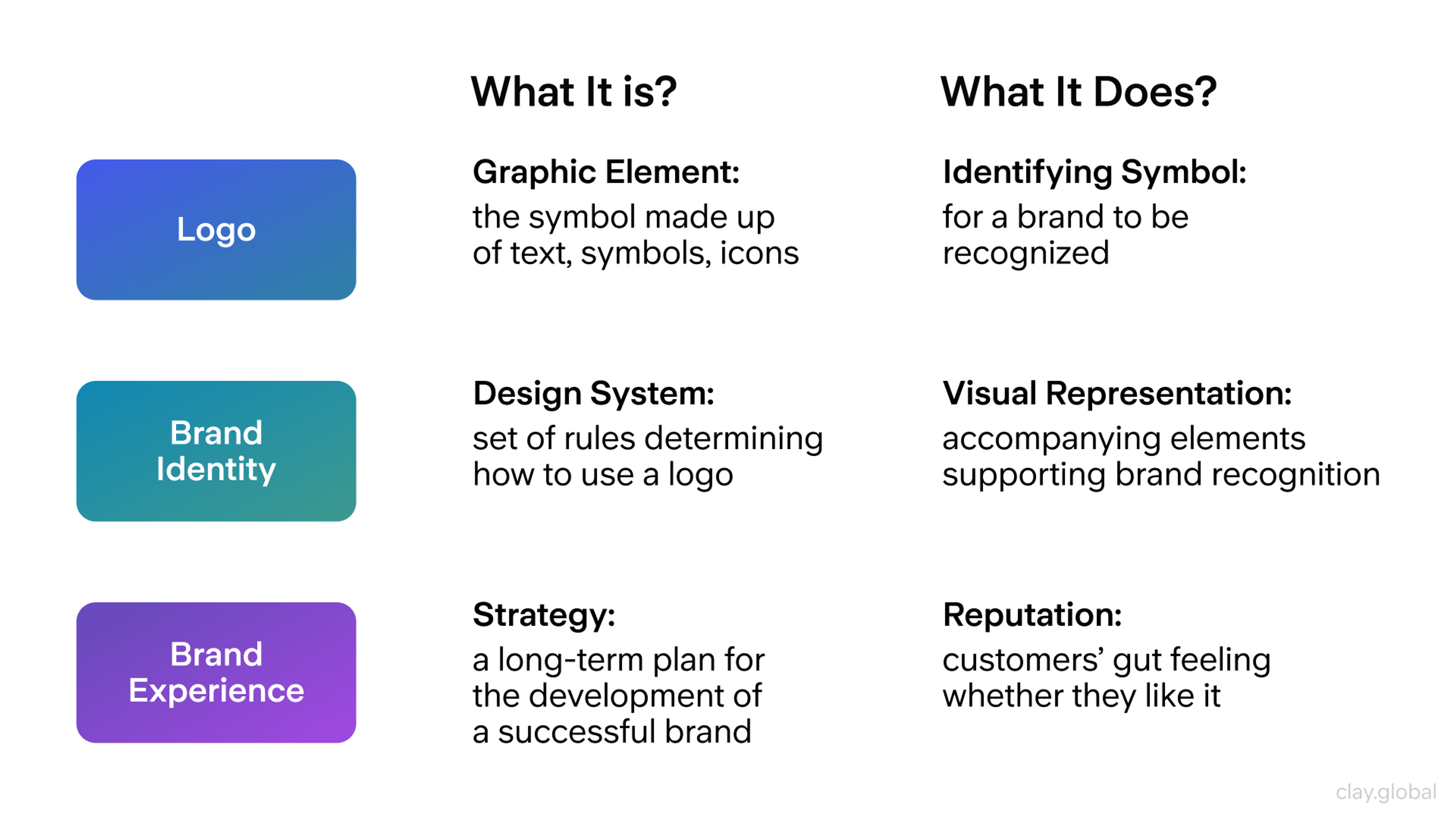
What Makes a Strong Brand Strategy?
Several key components must be present to be considered a successful brand strategy.
1.
One crucial element is establishing an emotional bond with customers based on shared values between the company and its audience.2.
It should differentiate itself from competitors through unique products or services.3.
A well-designed brand strategy also revolves around effectively communicating the company's core message to ensure easy accessibility for customers seeking information.4.
A strong brand strategy must be adaptable and evolve to meet consumers' constantly changing needs and preferences.
Does Digital Brand Strategy Differ from the Offline One?
Yes, but they should work together. A digital brand strategy focuses on online presence — websites, social media, SEO, email marketing, and digital ads. It’s about being visible where people spend most of their time online.
An offline brand strategy revolves around physical experiences — store design, packaging, print ads, events, and word-of-mouth interactions. It’s about making an impact in the real world.
While the channels differ, the core brand message should remain consistent. The best brands create seamless experiences, whether someone interacts with them through a website, a social post, or an in-person event.
Elements of Brand Strategy
A successful brand strategy comprises several key elements. These include creating a unique brand identity, developing a unified message, and conveying your business's values, tone of voice, storytelling ability, and overall feeling.
Brand Design Elements by Clay
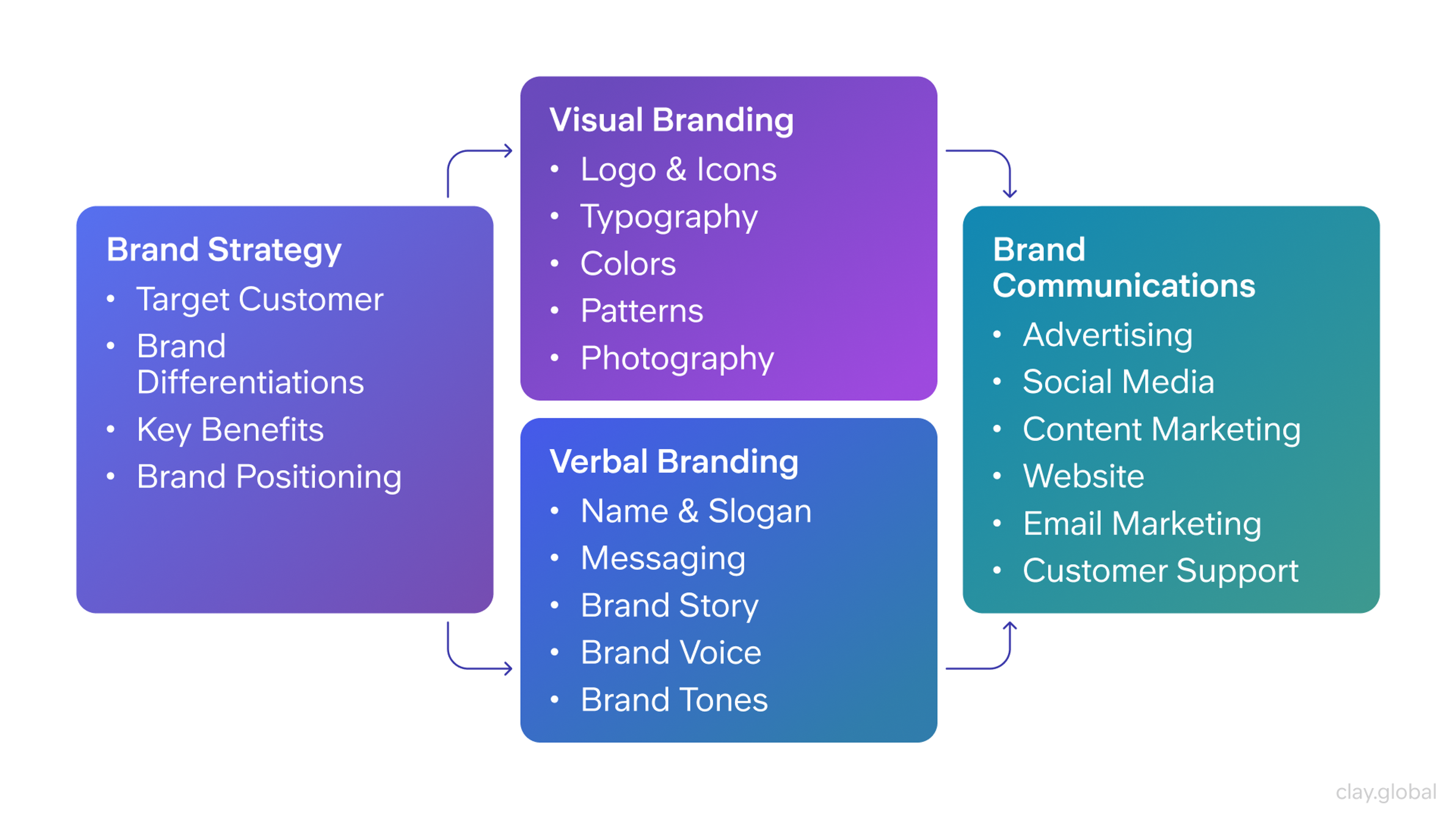
Verbal Brand Identity
Verbal identity encompasses how a brand expresses its beliefs, purpose, and character through language. This includes elements such as the brand name, tagline, slogans, tone, writing style, and vocabulary used in marketing communications. The verbal identity of a brand must be distinctive and consistent with the brand's persona and values.
It must resonate with the intended audience and set the brand apart from its competitors. A well-crafted verbal identity can establish a strong connection with customers, shaping their perception of the brand, influencing their purchasing decisions, and fostering loyalty.
Brand Values
Brand values are an integral part of brand management, as they reflect what you hold dear and should be evident in every aspect of your business. By establishing a clear set of brand values, you can effectively communicate your company's identity to potential customers.
These values are a compass for all decisions related to customer service, product development, marketing strategies, and beyond. They provide a guiding light for employees as they work towards delivering a memorable and unparalleled customer experience in every interaction. These values should be deeply ingrained within the company culture, consistently upheld, and constantly reinforced to ensure a solid and impactful brand image.
Brand Identity
Brand identity is the visual representation of a brand that sets it apart from others in the minds of consumers. It encompasses all aspects, such as color, design, and logo, to effectively communicate the brand's core values, personality, and essence.
A company can tell its unique story and establish itself as distinctive in the market through a compelling brand identity. A consistent brand identity across all platforms is essential to ensure recognition and provide a seamless experience for consumers.
Logos
Logos come in various forms, each with its unique appeal and purpose. There are wordmarks, which consist of the brand's name in a stylized font. Letterforms and monograms are logos created from one or more letters, generally the brand's initials.
Pictorial marks or brand marks are icon-based logos representing the brand through an image or shape. Abstract logo marks are geometric forms that don't establish an immediate connection to an existing image but are unique to the brand.
One intriguing advancement in logo design is the animated logo. These bring traditional logos to life, adding motion to capture attention and offer a more dynamic, engaging interaction with the audience. Animated logos are particularly effective in the digital space, where movement can make a brand stand out in a sea of static images.
For instance, CafePay’s logo is a brilliant example of a wordmark combined with a pictorial mark. The custom serif logotype spells out the brand name in an elegant, timeless font, while the accompanying logomark subtly evokes a clock, symbolizing reliability and precision in payroll management. We ensured the logo was unique and immediately recognizable, effectively communicating the brand's core values and purpose.
CafePay logo by Clay

Brand Design
Brand design is an essential aspect of developing a solid brand strategy. It entails creating visual brand identity elements that represent your business and differentiate it from others in the market.
These elements, including logos, color schemes, typography, and imagery, are compiled into a brand style guide. Consistent use of these elements across all channels is crucial, allowing customers to identify and associate your brand with its unique identity quickly.
Brand Story
A brand story is essential to brand strategies as it helps bring your company's values and identity to life. It tells why your business exists, what it stands for, and how it makes a difference.
A strong brand story should be told through engaging content that resonates with customers emotionally, such as videos, articles, or even customer testimonials. This type of storytelling can be used across all channels to ensure that customers recognize your unique identity wherever they encounter it.
Brand Story Process Template by Clay

Brand Architecture
Brand architecture is pivotal in an overall brand strategy, especially for organizations with a portfolio of brands, services, or products. Fundamentally, brand architecture outlines the structure of the brand within an organizational entity. It clarifies the brand's portfolio, revealing the relationships between the parent brand, subsidiary brands, products, and services.
A well-planned brand architecture helps avoid brand confusion among consumers. It ensures that each brand or sub-brand within an organization’s portfolio has a unique position and clear relationship to the parent brand. This helps prevent potential overlap or dilution of brand identities while maximizing brand equity across the entire portfolio.
Brand Style Guide and Brand Strategy
Basically, all these elements will later help you create a brand style guide - a documented set of guidelines that helps to maintain consistency and coherence in a brand's presentation across various platforms.
Connecting this with your brand strategy, the style guide ensures that the brand's identity, as defined by the strategy, is communicated consistently and effectively. The strategy outlines what your brand stands for, its core values, and its unique selling points. The style guide then translates these strategic elements into visual and verbal guidelines.
Quick Brand Strategy Template
- What is your brand striving to achieve, and how are you expressing those goals?
- What difficulties will your brand be able to solve, and how can it improve the lives of its target customers?
- Who would you like to have as your customers [the Buyer Persona]? What traits do they possess, and how can you target them effectively?
- Who will be positively impacted by the brand? How do these customers feel, and how can we make them feel better?
- How do you recognize your competitors? Who offers what potential customers need, and how are these services or products provided?
- What personality and tone of voice will your brand need to adopt to capture the attention of potential customers? How can you create an engaging experience for them?
Source: Smartsheet
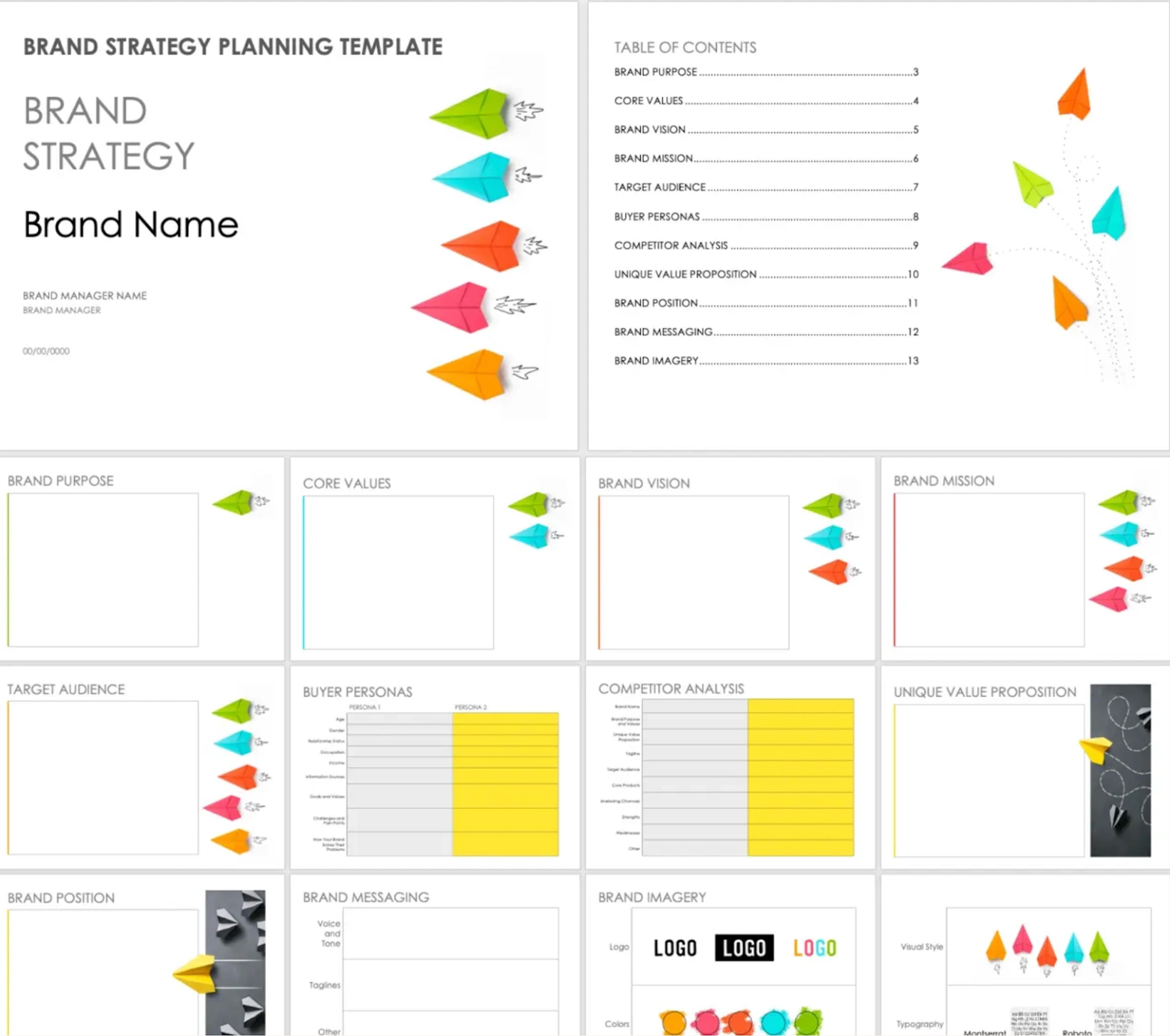
What Are the 4 C's of Brand Strategy?
The 4 C’s of brand strategy are like the building blocks of a brand’s identity. They focus on the customer experience and how your brand can meet their needs in a way that feels natural, valuable, and memorable. Let’s break it down in a more relatable way:
1. Customer
At the heart of your brand strategy is your customer. It’s not just about selling something — it’s about understanding who they are, what they care about, and how your brand can make their lives better. This means really getting to know your audience, whether through surveys, conversations, or simply paying attention to their feedback. Your brand is only as strong as its connection with the people it serves, so the more you understand their needs and desires, the more meaningful your brand can become.
2. Cost
Cost is about more than just setting a price tag on your product or service. It’s about finding the sweet spot between what your brand offers and what your customers are willing to pay. This isn’t just about affordability, either — it's about the perceived value. Are you offering a high-end experience or something more accessible? Whatever your pricing strategy, it needs to reflect the value you're providing and fit into the larger narrative of your brand. When your audience feels like they’re getting what they paid for — and then some — they’ll stick around.
The 4 C's of Brand Strategy by Clay

3. Convenience
In today’s fast-paced world, convenience matters more than ever. This part of your brand strategy is about making it easy for people to access your product or service, whether it's through a seamless online experience, easy-to-find stores, or even fast and friendly customer service. If people have to jump through hoops to get what they need from your brand, they’re likely to look elsewhere. A convenient, user-friendly experience makes your brand feel like a natural part of your customers’ lives rather than an obstacle.
4. Communication
Good communication is the glue that ties everything together. It’s about how your brand talks to its audience, from the way you market your products to the way you engage with people on social media or respond to customer inquiries. Your communication should always feel open, honest, and approachable. When you communicate clearly and consistently, your audience starts to feel like they truly know your brand, which builds trust and strengthens loyalty.
7 Types of Branding Strategy
Choosing the right brand strategy can be difficult, so it is essential to understand what type of brand you are trying to create and how to best communicate your brand messaging. Businesses can utilize several main types of brand strategies.
Marketing and Branding Strategies by Clay

Product Branding
Product branding is when a brand focuses on communicating the features and benefits of its products to persuade customers to purchase them. Product brand strategies should highlight why customers should choose your brand over others, what makes it different from competitors, and how it can improve their lives.
This brand development strategy relies heavily on effective marketing, such as advertisements, influencer marketing, and content creation. Branding a product is one of the most effective methods for creating name recognition and a strong brand identity.
By connecting an image, title, brand colors, and visuals to your product or service, you can construct an exclusive identity that will help customers distinguish it from others in its category.
It's become almost a mundane part of our everyday lives - the iconic logos of businesses like Coca-Cola, Apple, and Starbucks. Such unforgettable products have funneled into society so profoundly that we scarcely take notice anymore.
Source: Greg Balfour Evans / Alamy Stock Photo

Corporate Branding
Corporate branding is when a brand focuses on communicating its values to build customer trust and increase brand awareness. Corporate brand strategies should focus on conveying what makes the brand unique, how it can help improve customers' lives, and how it defines itself through its brand values.
By combining the strengths of two different brands, a fused brand is born - otherwise known as a brand partnership. This strategic marketing ploy has allowed businesses to expand their customer bases and increase perceived value by joining forces. The advantages are plentiful, from increased awareness in the marketplace to skyrocketing sales figures!
Through a co-branding alliance, Spotify, a music streaming app, and Uber, a ride-hailing service, are teaming up to bring customers "a soundtrack for their journey." This illustrates how two distinct companies with similar objectives — increasing user base — can collaborate successfully.
Source: Uber on X

Attitude Branding
Attitude branding is when a brand focuses on creating an emotional connection with its target audience by conveying a specific attitude or message.
Attitude branding strategies should focus on expressing the brand's personality and values to draw customers in and make them feel like they are part of something special. This brand strategy uses creative visuals, such as brand story, colors, fonts, and logos, to create its brand identity.
PalmPalm’s brand identity perfectly exemplifies attitude branding. By evoking a cool SoCal vibe inspired by Venice Beach sunsets, PalmPalm connects with a health-conscious, active audience. Through the brand's visual elements and storytelling, we created an emotional appeal that makes consumers feel part of a trendy, lifestyle-oriented community. This strategic use of design distinguishes PalmPalm from competitors and fosters a strong, relatable brand personality that resonates with its target market.
PalmPalm identity by Clay

Minimalist Branding
Minimalist branding is when a brand focuses on creating a simple and modern identity that can be easily identified. Minimalist brand strategies should use minimalistic visuals like white space, clean lines, and muted colors to convey the brand voice without overwhelming customers. This brand strategy relies heavily on sound design, such as brand guidelines and brand assets.
Apple has become the vanguard of 'extreme minimalism', revolutionizing how we view design.
Individual Branding
Individual brand strategies should focus on creating a brand identity for each brand, using visuals to help customers distinguish between products. This brand strategy promotes consistency and allows the company to appeal to multiple target markets. It also gives customers more options in product selection and provides greater visibility in the marketplace.
Procter & Gamble is an iconic company that boasts a massive collection of individual brands, such as Pantene, Olay, Vicks, and Pampers - just to name a few.
Source: Procter&Gamble

Brand Extension Branding
Brand extension branding is when a brand focuses on expanding its product offering or diversifying its brand to meet the needs of different customers.
Brand extension strategies should focus on creating unique brand experiences tailored to each customer's needs. This strategy promotes brand experiences through digital platforms like websites, apps, and blogs.
Gillette's innovative decision to produce shaving cream, foam, and gel, in addition to its renowned safety razor blades, was brilliant. After all, it can be challenging to envision someone shaving without any of these items. Thus, Gillette made a wise move by creating an essential accessory for its primary product.
Service Branding
With service branding, companies can take their services and turn them into products that are uniquely marketed to expand reach and sales. This strategy is crucial in contributing to the creation of brand identity as well as promoting economic growth within businesses.
Unlike tangible objects, services cannot be seen or touched. However, service branding enables providers to promote such offerings effectively and successfully.
For instance, IKEA offers an exceptional service in designing the interiors of any room in your house in 3D using items from its collections.
Photo by Zheka Kapusta on Unsplash

What Is the Best Brand Development Strategy?
Choosing the best branding strategy isn’t as simple as picking the top option — it really depends on your business, your goals, and the audience you want to reach. Every strategy has its time and place, so let’s break it down in a way that feels more relatable.
If you have a wide range of products that appeal to different groups of people, individual branding might be the way to go. It gives each product its own personality and identity so customers understand exactly what they’re getting. Think of it like having separate brands for each of your children — each one is unique, and they each get their own special attention. But be prepared: it takes a lot of effort and resources to build up each product’s individual reputation.
On the flip side, if your company wants to create a strong, unified front across different products, umbrella branding is a solid choice. This is when you tie all your products to the same overarching brand. Apple, for example, uses umbrella branding — everything from iPhones to MacBooks feels connected under the same Apple umbrella, which makes things easier for customers. It saves money and builds consistency, but it can limit the freedom to create completely unique identities for each product.
Then there’s co-branding, which is like teaming up with a friend who shares your interests and strengths. This strategy works when two brands with similar audiences decide to collaborate. Think of when Nike teamed up with Apple to create fitness gadgets. It’s a powerful way to expand your reach and credibility by borrowing some of your partner’s influence, and it helps split the marketing costs.
Personal branding is a game changer for those in the personal or creative space. It’s about putting yourself at the forefront, like how Oprah or Elon Musk have built massive brands based on their personalities. Personal branding can turn you into a powerhouse if your audience connects with you directly and trusts your expertise or vibe. It’s all about building relationships and showing your true self.
Brand Development Strategies by Clay
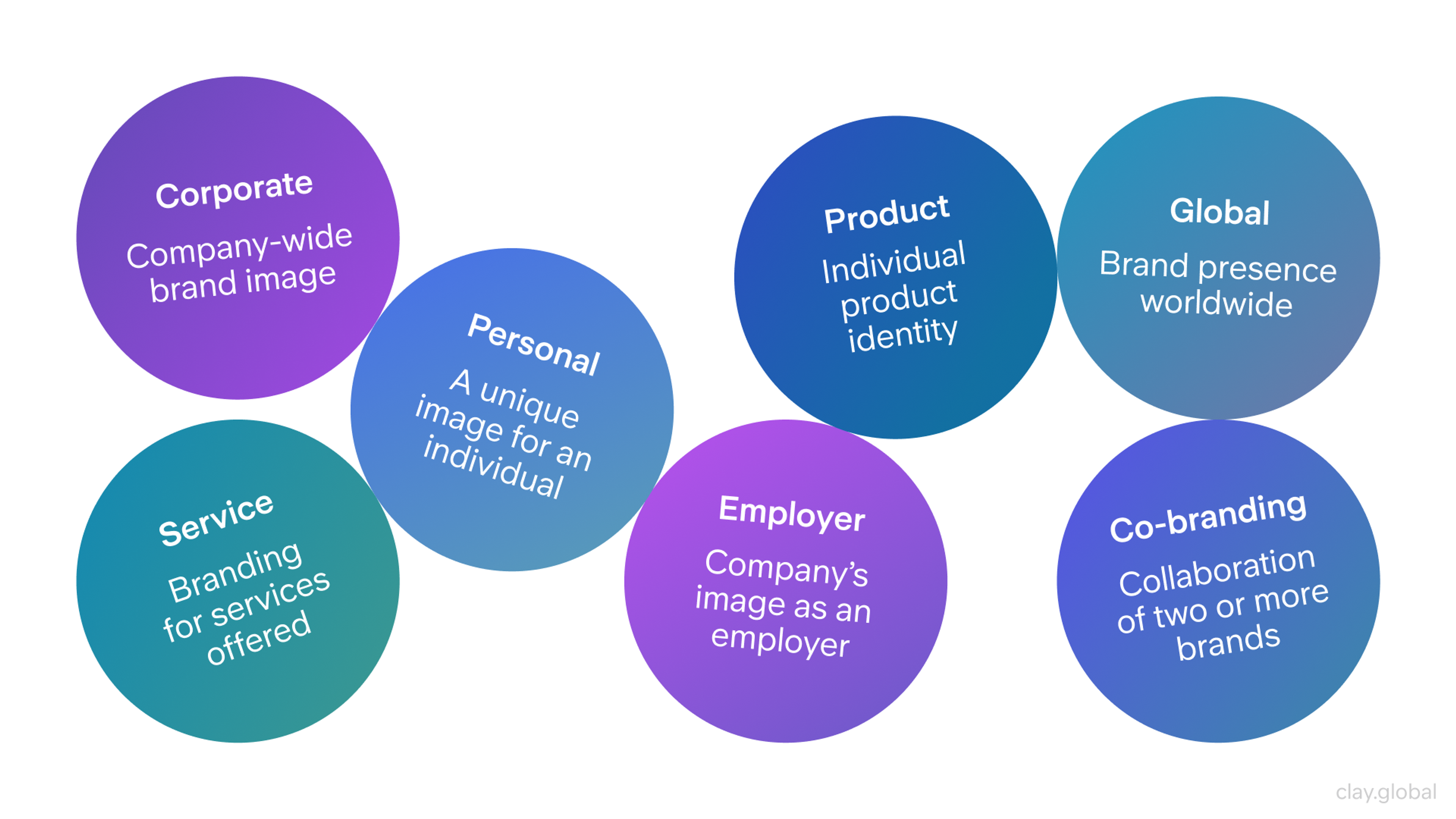
If your business revolves around a product that’s your main focus, product branding can really help. This is when you give your product its own identity, separate from the company itself. It’s great for businesses that have a standout product that deserves individual recognition. For example, Coca-Cola and Diet Coke are distinct from each other, even though they’re part of the same brand. This strategy helps each product shine on its own.
When you’re in the service industry, service branding is key. It’s less about a physical product and more about the experience you provide. Think of Starbucks — when you walk into one of their stores, it’s not just about the coffee. It’s about the experience, the service, the vibe, and the feeling of being welcomed. This strategy works best when the emotional connection with your customers is at the heart of what you do.
Finally, if you have a retail business, retail branding is a must. This is where the overall shopping experience becomes your brand. From the layout of your store to how your employees interact with customers, it all matters. Think about how a brand like IKEA makes the shopping experience fun and memorable. It’s not just about the products—they create an environment that customers want to come back to again and again.
So, which strategy is the best? It really comes down to what you're trying to achieve. Whether you’re trying to build personal connections, stand out with a unique product, or create a seamless, consistent experience across your offerings, the right branding strategy will make all the difference. And in some cases, blending a few of these strategies can be the magic formula for success. The key is understanding who you are as a brand and how you want to connect with your audience in an authentic, lasting way.
Branding Methods
Effective brand strategies involve a variety of creative branding methods. These include:
- Advertising campaigns
- Content marketing
- Influencer marketing
- SEO optimization
- Strategic partnerships
Each of these techniques can be used to create an attractive image for your business and reach out to potential customers. It's essential to research which methods will work best for you and find innovative ways to communicate your message.
Advertising Campaigns
Advertising campaigns are powerful tools for reaching potential customers and creating an attractive image for your brand. This branding strategy captures customers' attention and draws them with engaging content.
Source: Richard Levine / Alamy Stock Photo

Advertising campaigns are a vital part of any powerful brand strategy. They provide an effective avenue to showcase your company's brand positioning and reach new customers.
Advertising campaigns can draw out emotion from potential customers and create an unforgettable experience for them through creative visuals, copywriting, storytelling, and strategic placement. These campaigns can be implemented on various platforms, from TV and radio to print and digital media.
Content Marketing
Content marketing plays a crucial role in developing any powerful brand strategy. It encompasses creating captivating content that captures the attention of potential customers and effectively communicates your business's message.
Through content marketing, you can elevate brand awareness and highlight your company's distinctive principles. This can be achieved through diverse mediums, including but not limited to blogs, videos, podcasts, eBooks, and social media content.
Social Media Campaigns
Social media campaigns are a great way to reach your target audience and introduce them to your existing or new brand. These campaigns can involve running ads on social media platforms or creating content tailored to each platform. The key is to find out which platforms your target customers use and create engaging content for them.
Source: nensuria / iStock

Influencer Marketing
Influencer marketing is a great way to reach potential customers and build a connection with them. Influencers have built an audience of followers on social media who trust their opinions, so if an influencer promotes your brand, it can have a powerful effect on potential customers.
SEO Optimization
Search engine optimization (SEO) improves your website's visibility in search engine results to attract more customers. It includes optimizing your content, keywords, and page structure so that popular search engines like Google can easily crawl and rank your website. SEO plays a crucial role in any effective brand strategy, ensuring the target audience can discover your website when searching for relevant keywords.
Source: Ahrefs
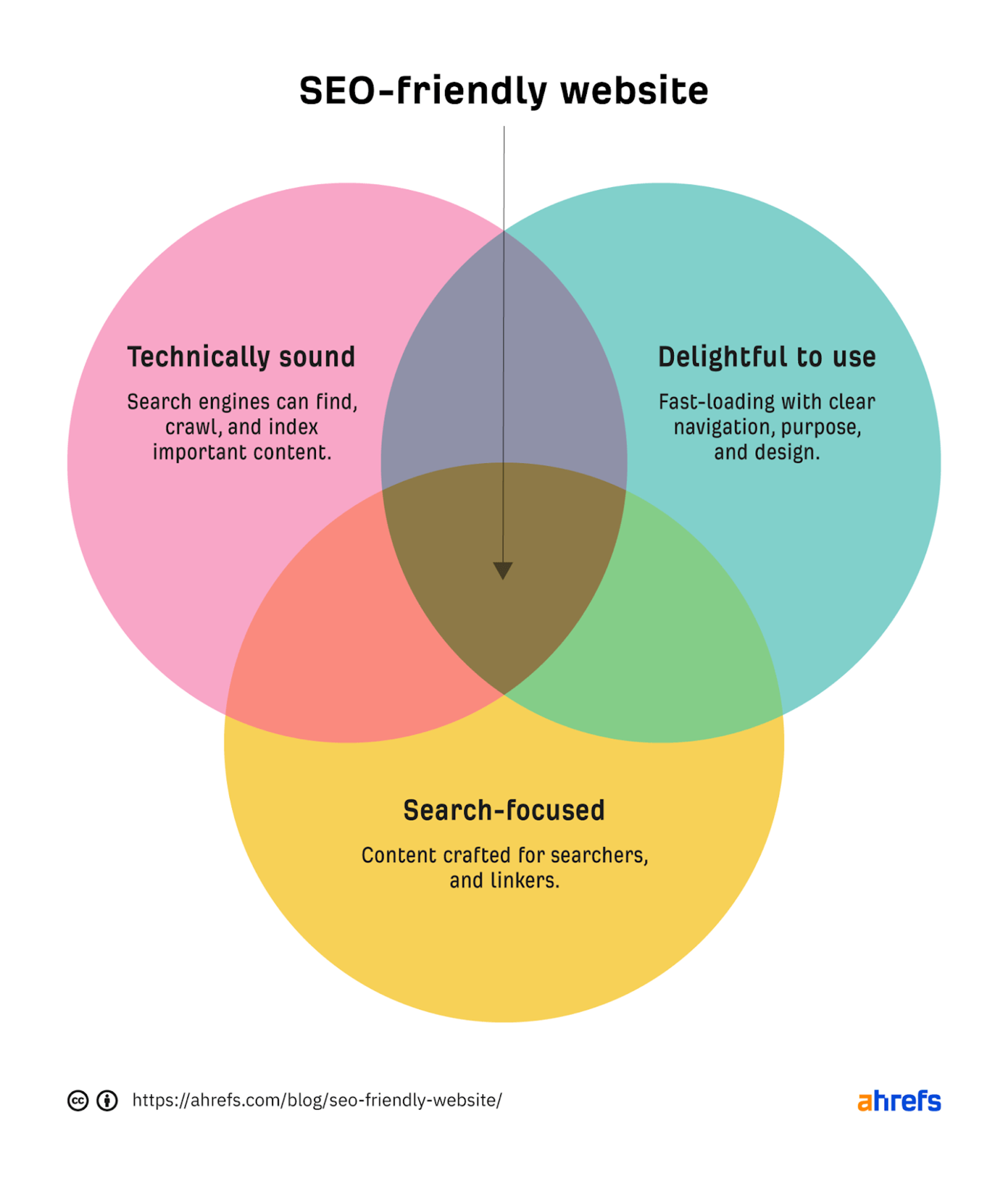
Strategic Partnerships
Strategic partnerships are a great way to reach out to potential customers and build relationships with them. By partnering with other businesses or organizations, you can create a robust network of customers, promote your brand’s mission, and extend your brand's reach.
Brand Strategy Examples
The most memorable brands don’t just sell products. They spark emotions, start conversations, and build communities. Here are five brands that have found unique ways to make their mark:
1. Oatly – The Rebel with a Cause
Oatly doesn’t sound like a typical oat milk brand—and that’s the point. Their packaging talks to you like a friend with a dry sense of humor, and their ads feel more like social commentary than product marketing. By embracing a playful, almost rebellious tone (while staying true to their sustainability mission), they’ve turned oat milk into a lifestyle choice.
Source: 303 London

2. Glossier – Built by the People, for the People
Glossier feels less like a big beauty brand and more like a best friend who gets you. Instead of pushing out marketing campaigns from a corporate office, they built their brand by listening to their community. Their minimalist pink packaging, dewy skin aesthetic, and social media-driven approach make people feel part of something, not just buying a product.
3. Liquid Death – Making Water Cool Again
Who knew canned water could be edgy? Liquid Death did. Their brand is loud, in-your-face, and full of dark humor—turning something as basic as hydration into a lifestyle. With slogans like “Murder Your Thirst” and a commitment to killing plastic waste, they’ve built a cult following by making people laugh while actually caring about the planet.
Source: Marketing Week

4. Aesop – The Brand That Whispers
Aesop doesn’t scream for attention—it doesn’t have to. Their stores feel more like art galleries than retail spaces, and their branding is all about quiet luxury. With a focus on natural ingredients, minimalist design, and an almost meditative in-store experience, they’ve turned skincare into a ritual rather than just a routine.
5. Notion – The Productivity Tool You Want to Use
Notion didn’t grow through big ad campaigns; it grew because people genuinely love using it. It’s sleek, simple, and endlessly customizable, making it feel like it was made just for you. By letting users shape their own experience and building a passionate online community, Notion has turned productivity into something (dare we say) fun.
Source: Notion

At the end of the day, the best brands don’t just sell a product — they create a feeling, a movement, or even a little bit of magic.
Read More
Final Thoughts
In today's cutthroat market, establishing brand value is crucial for any business's success. Businesses can build a strong and attractive image that resonates with their target audience by utilizing various impactful techniques such as advertising campaigns, content marketing, social media promotions, influencer collaborations, SEO optimization, and strategic partnerships.
These tactics increase brand awareness and establish a deeper connection between customers and the company's core values. With careful planning and execution, businesses can cultivate a loyal following of consumers who trust their brand message.


About Clay
Clay is a UI/UX design & branding agency in San Francisco. We team up with startups and leading brands to create transformative digital experience. Clients: Facebook, Slack, Google, Amazon, Credit Karma, Zenefits, etc.
Learn more

About Clay
Clay is a UI/UX design & branding agency in San Francisco. We team up with startups and leading brands to create transformative digital experience. Clients: Facebook, Slack, Google, Amazon, Credit Karma, Zenefits, etc.
Learn more


